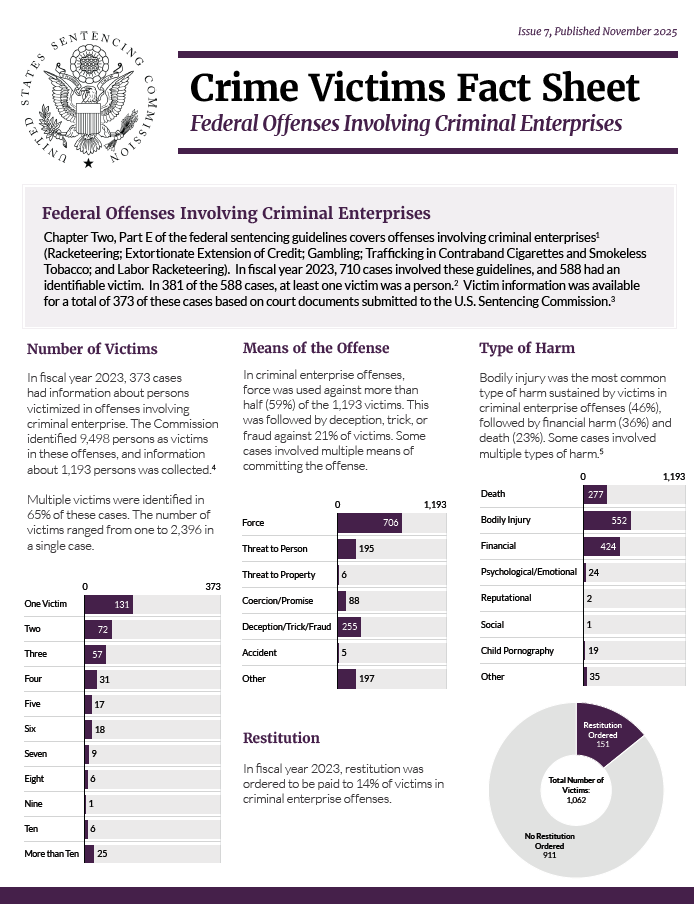CRIME VICTIMS FACT SHEET
Federal Offenses Involving Criminal Enterprises
Chapter Two, Part E of the federal sentencing guidelines covers offenses involving criminal enterprises1 (Racketeering; Extortionate Extension of Credit; Gambling; Trafficking in Contraband Cigarettes and Smokeless Tobacco; and Labor Racketeering).
In fiscal year 2023, 710 cases involved these guidelines, and 588 had an identifiable victim. In 381 of the 588 cases, at least one victim was a person.2 Victim information was available for a total of 373 of these cases based on court documents submitted to the U.S. Sentencing Commission.3
Click the button for a PDF or learn more below.
NUMBER OF VICTIMS
In fiscal year 2023, 373 cases had information about persons victimized in offenses involving criminal enterprise. The Commission identified 9,498 persons as victims in these offenses, and information about 1,193 persons was collected.4
Multiple victims were identified in 65% of these cases. The number of victims ranged from one to 2,396 in a single case.
MEANS OF THE OFFENSE
In criminal enterprise offenses, force was used against more than half (59%) of the 1,193 victims. This was followed by deception, trick, or fraud against 21% of victims. Some cases involved multiple means of committing the offense.
TYPE OF HARM
Bodily injury was the most common type of harm sustained by victims in criminal enterprise offenses (46%), followed by financial harm (36%) and death (23%). Some cases involved multiple types of harm.5
RESTITUTION
In fiscal year 2023, restitution was ordered to be paid to 14% of victims in criminal enterprise offenses.
RELATIONSHIPS BETWEEN VICTIMS AND INDIVIDUALS WHO CAUSED HARM
In criminal enterprise offenses, the most common association between victims and the individuals who caused them harm was as a stranger (41%). The next most common was as an acquaintance (34%). Some cases involved multiple relationship types.
86% of victims in criminal enterprise offenses were harmed by more than one individual.
VULNERABILITY
Some criminal enterprise offenses involved victims who were unusually vulnerable due to age, physical or mental condition, or other factors.6 The Commission identified 14% of victims in these cases as unusually vulnerable for one of these reasons. Some cases involved multiple vulnerabilities.
VICTIM CHARACTERISTICS
Almost one-sixth (15%) of victims in criminal enterprise offenses were juveniles.
Almost one-quarter (24%) of victims in criminal enterprise offenses were female.
ENDNOTES
1 Federal Offenses Involving Criminal Enterprises include individuals sentenced in fiscal year 2023 in cases involving USSG §§2E1.1 (Unlawful Conduct Relating to Racketeer Influenced and Corrupt Organizations ); 2E1.2 (Interstate or Foreign Travel or Transportation in Aid of a Racketeering Enterprise); 2E1.3 (Violent Crimes in Aid of Racketeering Activity); 2E1.4 (Use of Interstate Commerce Facilities in the Commission of Murder-For-Hire ); 2E2.1 (Making or Financing an Extortionate Extension of Credit; Collecting an Extension of Credit by Extortionate Means); 2E3.1 (Gambling Offenses; Animal Fighting Offenses); 2E4.1 (Unlawful Conduct Relating to Contraband Cigarettes and Smokeless Tobacco); 2E5.1 (Offering, Accepting, or Soliciting a Bribe or Gratuity Affecting the Operation of an Employee Welfare or Pension Benefit Plan; Prohibited Payments or Lending of Money by Employer or Agent to Employees, Representatives, or Labor Organizations); or 2E5.3 (False Statements and Concealment of Facts in Relation to Documents Required by the Employee Retirement Income Security Act; Failure to Maintain and Falsification of Records Required by the Labor Management Reporting and Disclosure Act; Destruction and Failure to Maintain Corporate Audit Records). Multiple sentencing guidelines may have been applied in these cases, including some not listed above.
2 An identifiable victim can be a person, business, government, or other type. This series provides victim information on persons.
3 The Commission’s Crime Victims Fact Sheets series relies on information collected and analyzed through a special coding project undertaken by the Commission to gather information beyond what is regularly collected and reported on by the Commission.
4 The sentencing documents received from the courts by the Commission are often focused on the sentencing event; therefore, some information regarding the victims of the offense was not provided in the documents available for staff review. For this reason, the total number of cases with complete information, and the corresponding number of victims in those cases, will vary by analysis. Victim information was collected for the first ten persons documented in the records.
5 In a small number of cases, the type of harm resulted from additional counts of conviction for offenses other than the ones discussed in this fact sheet. All of the harm types involved in a case are reported in this fact sheet.
6 In some, but not all, of these cases the court applied the adjustment at USSG §3A1.1. Vulnerability due to advanced age or youthfulness was determined by the offense conduct stated in the presentence investigation report adopted by the court, and not based on any minimum or maximum age.
SOURCE: U.S. Sentencing Commission, 2023 Victim Datafile, VICFY23.

